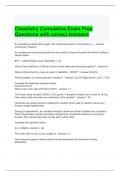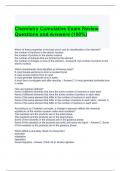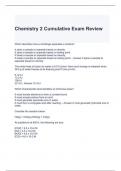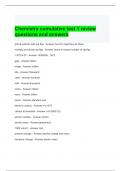Cumulative chemistry - Study guides, Class notes & Summaries
Looking for the best study guides, study notes and summaries about Cumulative chemistry? On this page you'll find 307 study documents about Cumulative chemistry.
Page 4 out of 307 results
Sort by

-
Cumulative Exam (Chemistry) Questions and Answers Already Passed
- Exam (elaborations) • 14 pages • 2024
-
Available in package deal
-
- $9.99
- + learn more
Cumulative Exam (Chemistry) Questions and Answers Already Passed In the context of a redox reaction, what does reduction mean? The acquisition of electrons. The loss of electrons. The formation of a new substance. The transfer of protons. How is the Au3+ ion characterized? It acts as the oxidizing agent. It is the reducing agent. It is neutral. It is the substance being reduced. In a disproportionation reaction, what feature does the reacting substance possess? It exhibi...
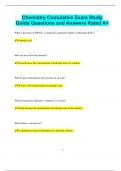
-
Chemistry Cumulative Exam Study Guide Questions and Answers Rated A+
- Exam (elaborations) • 17 pages • 2024
-
Available in package deal
-
- $9.99
- + learn more
Chemistry Cumulative Exam Study Guide Questions and Answers Rated A+ What is the name of H2CO3, a compound commonly found in carbonated drinks? carbonic acid How can an acid be best defined? An acid raises the concentration of hydrogen ions in a solution. Which sign would indicate the presence of an acid? It reacts with certain metals to generate a gas. What characteristic indicates a substance is an acid? Acids increase the concentration of hydrogen ions in the solution. ...
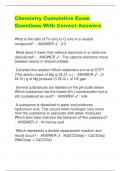
-
Chemistry Cumulative Exam Questions With Correct Answers
- Exam (elaborations) • 4 pages • 2024
-
- $9.64
- + learn more
Chemistry Cumulative Exam Questions With Correct Answers What is the ratio of Fe ions to O ions in a neutral compound? - ANSWER : 2:3 What does it mean that valence electrons in a metal are delocalized? - ANSWER : The valence electrons move between atoms in shared orbitals. Consider the reaction Which statement is true at STP? (The atomic mass of Mg is 24.31 u.) - ANSWER : (3 24.31) g of Mg produce (3 22.4) L of H2 gas. Several substances are labeled on the pH scale below Whi...
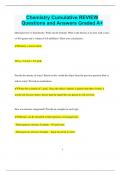
-
Chemistry Cumulative REVIEW Questions and Answers Graded A+
- Exam (elaborations) • 16 pages • 2024
-
Available in package deal
-
- $9.99
- + learn more
Chemistry Cumulative REVIEW Questions and Answers Graded A+ Determine how to find density. Write out the formula. What is the density of an item with a mass of 40.0 grams and a volume of 8.0 milliliters? Show your calculations. Density = mass/volume 40.0 g ÷ 8.0 mL = 5.0 g/mL Provide the density of water? Based on this, would the object from the previous question float or sink in water? Provide an explanation. Water has a density of 1 g/mL. Since the object’s density is greater ...
Chemistry Cumulative Exam Prep Questions with correct Answers
Chemistry Cumulative Exam Review Questions and Answers (100%)
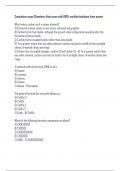
-
Cumulative exam Chemistry final exam with 100% verified solutions from expert
- Exam (elaborations) • 20 pages • 2024
-
- $21.49
- + learn more
Cumulative exam Chemistry final exam with 100% verified solutions from expert What makes carbon such a unique element? A) Elemental carbon comes in two forms, diamond and graphite. B) Carbon forms four bonds, although the ground state configuration would predict the formation of fewer bonds. C) Carbon forms covalent bonds rather than ionic bonds. D) To a greater extent than any other element, carbon can bond to itself to form straight chains, branched chains and rings. E) Carbon has ...
Chemistry 2 Cumulative Exam Review
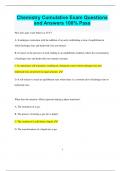
-
Chemistry Cumulative Exam Questions and Answers 100% Pass
- Exam (elaborations) • 18 pages • 2024
-
Available in package deal
-
- $9.99
- + learn more
Chemistry Cumulative Exam Questions and Answers 100% Pass How does pure water behave at 25°C? A. It undergoes ionization with the addition of an acid, establishing a state of equilibrium in which hydrogen ions and hydroxide ions are formed. B. It ionizes in the presence of acid, leading to an equilibrium condition where the concentration of hydrogen ions and hydroxide ions remains constant. C. It experiences self-ionization, resulting in a balanced system where hydrogen ions and hyd...
Chemistry cumulative test 1 review questions and answers

Did you know that on average a seller on Stuvia earns $82 per month selling study resources? Hmm, hint, hint. Discover all about earning on Stuvia

